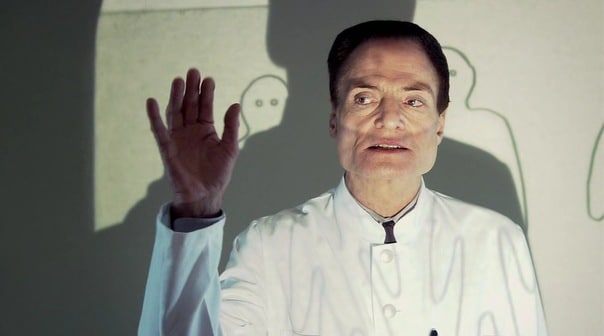As a Swedish death metal musician once asked, ‘Who examines the doctors?’ and it’s a fair question, speaking to an anxiety which crops up again and again in horror cinema. Little wonder it does, too: ever since Victor Frankenstein decided to use his university education to stitch together dead bodies as a scholar of the ‘unhallowed arts’, people going rogue with medical expertise has formed a key component of the genre, somewhere we can play with our very real worries about these people abusing their skills, position and power. Here are some of my favourites…

5 Doctor Freudstein/House By The Cemetery
When you need to be nailed into a basement, you probably know your bedside manner isn’t what it ought to be. Freudstein is a classic Fulci monster – you don’t quite know what he is, but you can be assured that the kills are going to be particularly brutal. Turns out that Freudstein is an apt moniker, seeing as this strange zombie ghost fella offs his own family to use them as experimental fodder: he stays alive by using red blood cells from his victims, and the only thing more dangerous than him turns out to be someone trying to rescue their creepily-overdubbed young son by smashing through a door with a hatchet. Come to think of it, Fulci films seem to be as choc-ful of nearly fatal rescue attempts as they are monsters.

4 – Doctor West/Re-Animator
It would be remiss of me to leave out Doctor Herbert West – brilliant, groundbreaking and of course utterly amoral, committed only to experiments which further his quest to cheat death. If that means testing the Re-Agent (in the appropriate ‘bad science’ colour of lurid green) on people he knew, well hey, it’s the gift of life. The only thing which really gets him exercised is the prospect of someone else taking the credit for his work: still, this gives us West’s knock-out line, after he decapitates his great rival, Dr Hill, “You’ll never take credit for my discoveries – who’s going to believe a talking head? Get a job in a sideshow.” Played with deadpan, egotistical verve by Jeffrey Combs, this is a world away from the Lovecraft short story which inspired it, but gives us one of the best ‘mad scientists’ in horror – and another renegade use for a basement.

3 – Doctor Heiter/The Human Centipede
The Human Centipede was always going to be divisive, but I’ve always seen the first film as part of the ‘mad scientist’ tradition – admittedly, Victor Frankenstein didn’t have much to say about stitching the living together, but THC follows in its wake to an extent, combining the noughties predilection with unremitting torment and the older tradition of medical practice gone bad. At the heart of this is Dieter Laser’s turn as Doctor Heiter, who decides to make the best of an unexpected arrival at his door. Originally an expert in separating conjoined twins, in his retirement Heiter decided to do things the other way around, joining people together (and neatly recasting them as a single entity, once the stitches are in.) Laser was always in the frame for the part, even before reading for it, and his intensity as Heiter certainly helps the film land its considerable punches: the complete dehumanisation of his victims is successfully portrayed by Laser, who regards the three people as a ‘pet’ and rejoices in his experimental surgery. “FEED HER!”

2 Doctor Channard/Hellbound: Hellraiser II
Hellbound is, to my mind, the only really successful entrant in what has now become a sprawling mass of Hellraiser sequels, many of which seem to bear little resemblance to the original film. Hellbound, however, boasts an interesting direction, creating a vision of Hell and an antagonist worthy of the Cenobites. Doctor Channard has been seeking access to this other world for years, using his position and influence as director of the Channard Institute (an asylum by any other name) to further his aims. One of the film’s key scenes, for me, is of a roomful of hapless patients each trying to solve Lament Configuration boxes – it brings a structured and methodical approach to something supernatural, which sums up Channard quite neatly. Leviathan, the God of the Underworld, does not kill Channard – it simply transforms him, giving him a grotesque appearance which matches his cruelty and empowering him still further. And to think…he hesitated…

1 – Doctor Pretorius/Bride of Frankenstein
And so we come full circle, to a film based on the story which arguably gave birth to the sub-genre – and another sequel, too, which many people regard as superior to the earlier film. Part of the reason for the great success of Bride of Frankenstein is surely the performance of Ernest Thesiger as Doctor Septimus Pretorius, which is certainly a name to conjure with. And Thesiger more than lives up to the part: an old associate of Aleister Crowley’s, Thesiger brings glee and old world wit to the role, toasting a “new world of gods and monsters” as he prepares to make the creature a mate. He schemes, lies and manipulates to achieve this ambition, but with such panache that he’s of course forgiven: a man who can use a coffin as a picnic table probably has more than his share of amorality, but Thesiger carries all before him, with gin his only weakness. Or is it cigars? A mad scientist without compare, not for nothing does Pretorius compare himself to the devil; his wry pride and ambition have influenced many of the films which followed in the wake of Bride of Frankenstein, and certainly helped to establish a subgenre which is grisly, unsettling good fun.
